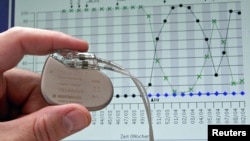Patients whose hearts need a bit of help keeping the beat are often given a pacemaker, which delivers electrical pulses to regulate heartbeats. The tiny electronic devices, surgically implanted beneath the skin on the chest, must be replaced every five to seven years when their batteries run out.
But an experimental device that converts energy from the heartbeat itself could provide enough electricity to operate the pacemaker indefinitely. The cardiac energy harvester uses piezoelectricity, the energy produced by motion, such as vibrations caused by a heartbeat.
Dr. M. Amin Karami, who led the study at the University of Michigan in Ann Arbor, said the prototype, which is about half the size of the current battery pack, generated more than 10 times the power that modern pacemakers require. He suggested piezoelectricity might also be used to power other implantable cardiac devices.
The researchers hope to integrate their technology into commercial pacemakers, eliminating the need for repeated surgeries to replace pacemakers with depleted batteries.
But an experimental device that converts energy from the heartbeat itself could provide enough electricity to operate the pacemaker indefinitely. The cardiac energy harvester uses piezoelectricity, the energy produced by motion, such as vibrations caused by a heartbeat.
Dr. M. Amin Karami, who led the study at the University of Michigan in Ann Arbor, said the prototype, which is about half the size of the current battery pack, generated more than 10 times the power that modern pacemakers require. He suggested piezoelectricity might also be used to power other implantable cardiac devices.
The researchers hope to integrate their technology into commercial pacemakers, eliminating the need for repeated surgeries to replace pacemakers with depleted batteries.





